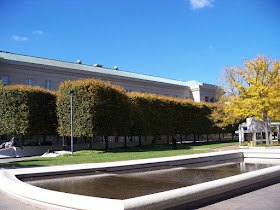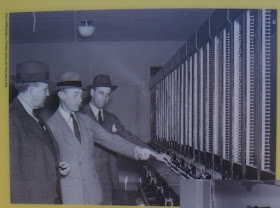Above: The Municipal Court building at 510 Fourth Street, NW, Washington, DC. Among the offices inside this building today are the Small Claims Court and the Landlord and Tenant Branch of the DC Courts.
Above: A cornerstone on the Municipal Court Building shows that it was built in 1939; that the primary architect was Nathan C. Wyeth; and that it received funding from the Federal Emergency Administration of Public Works (or "Public Works Administration," PWA).
Above: This is the side of the Municipal Courthouse that faces a courtyard - a courtyard that serves as the home of the National Law Enforcement Officers Memorial.
Above: This is part of the National Law Enforcement Officers Memorial. On the low wall, under the trees, are inscribed the names of officers who died in the line of duty. Also, an inscription under a nearby statue reads, "It is not how these officers died that made them heroes, it is how they lived."
Above: On the other side of the National Law Enforcement Officers Memorial (i.e., across the courtyard from the Municipal Courthouse) is the old "Police Court" building, which today houses offices such as the Probate Division of the Superior Court of DC. It appears to be a sister building to the Municipal Court building.
Above: A cornerstone on the Police Court building shows that it was built in 1937, and that Nathan C. Wyeth was again the primary architect. It's possible that New Deal funding was also utilized for the construction of this building, but we can't tell for sure from the cornerstone.
Above: This is an aerial photo of Washington, DC's Judiciary Square. The red building at the top center of the photo is the National Building Museum. The National Law Enforcement Officers Memorial is in front of the National Building Museum, where you see the rows of trees in a circular pattern. The Municipal Court building is the rectangular building with the greenish roof, to the right (our right) of the Officers Memorial courtyard. The Police Court is the rectangular building to the left of the courtyard. Now, see the two smaller square buildings, with the same color roofs as the Municipal & Police Court buildings? One or both of them may have been designed by Nathan Wyeth, and built with New Deal funding. A nearby waymarker talks of a Juvenile Court building constructed in this area, at 409 E Street, by Wyeth, during the 1930s. However, when I visited Judiciary Square in November of this year, there was so much construction going on (and the uses and addresses of some of the buildings seems to have changed over the decades) that it was impossible for me to tell which of the many buildings was the old Juvenile Court building. The large building at the bottom right of the photograph is the DC Municipal Building. This is a New Deal funded building, which I blogged about here. Photo courtesy of Wikipedia.
Above: The waymarker, about a block away from the Municipal Court Building.
Above: This photograph on the waymarker shows Nathan Wyeth (center).
Above: A closer look at the text on the waymarker. Among other things, it highlights how government-funded public work projects can keep people employed, productive, and hopeful. Compare that to our culture today, where laid-off workers are routinely scolded by their political representatives and also their fellow citizens - called "parasites," "takers," and "lazy good-for-nothings." Which approach do you prefer? Condemning and laughing at people who've lost their jobs & livelihoods through no fault of their own... or giving them employment on useful public works? Sadly, it's been my observation and experience that a large percentage of Americans prefer the former. And that's a big part of the reason why we don't make things anymore; why our infrastructure has rotted away; and why children are drinking lead-contaminated water all across the country while the Forbes 400 laughs and enjoys record wealth. Our New Deal ancestors understood the value of the common good. Us? Neh, not so much. We've been brainwashed into worshiping the holy "JOB CREATORS" - showering them with praise & tax breaks, while our children drink lead from crumbling water systems.
Above: The waymarker, about a block away from the Municipal Court Building.
Above: This photograph on the waymarker shows Nathan Wyeth (center).
Above: A closer look at the text on the waymarker. Among other things, it highlights how government-funded public work projects can keep people employed, productive, and hopeful. Compare that to our culture today, where laid-off workers are routinely scolded by their political representatives and also their fellow citizens - called "parasites," "takers," and "lazy good-for-nothings." Which approach do you prefer? Condemning and laughing at people who've lost their jobs & livelihoods through no fault of their own... or giving them employment on useful public works? Sadly, it's been my observation and experience that a large percentage of Americans prefer the former. And that's a big part of the reason why we don't make things anymore; why our infrastructure has rotted away; and why children are drinking lead-contaminated water all across the country while the Forbes 400 laughs and enjoys record wealth. Our New Deal ancestors understood the value of the common good. Us? Neh, not so much. We've been brainwashed into worshiping the holy "JOB CREATORS" - showering them with praise & tax breaks, while our children drink lead from crumbling water systems.










No comments:
Post a Comment